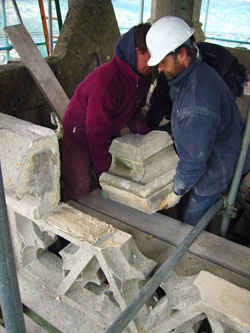St Stephens Church, Lansdown in Bath.
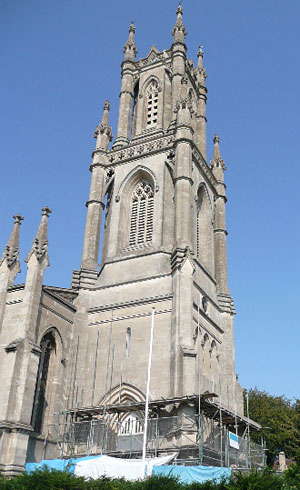 The lantern tower of St Stephen's Church, Lansdown, known affectionately
as the tower on the hill, is a very exposed and much loved landmark on
the Bath skyline. Last year is was also briefly employed as a barometer
to the current state of the environment. Minerva Stone Conservation was
commissioned by the parish and the Building Surveyor Alan Hardiman to undertake
repairs to the tower. The tower, built between 1840 and 1845, was constructed
in three stages: it has a square base, an octagonal tower and is topped
by impressive freestanding corner pinnacles that are attached by traceried
flying buttresses. Built in the local Stoke Ground Bathstone, the tower,
like all old buildings, has acted like a butterfly net capturing the worst
of wind, rain, and pollution. Professionally we were familiar with sulfurous
pollution and the damage that acid rain wreaks on the historic environment
but it was interesting to discover about other man made threats to the
wider environment, the effects of which as yet are not fully understood.
The lantern tower of St Stephen's Church, Lansdown, known affectionately
as the tower on the hill, is a very exposed and much loved landmark on
the Bath skyline. Last year is was also briefly employed as a barometer
to the current state of the environment. Minerva Stone Conservation was
commissioned by the parish and the Building Surveyor Alan Hardiman to undertake
repairs to the tower. The tower, built between 1840 and 1845, was constructed
in three stages: it has a square base, an octagonal tower and is topped
by impressive freestanding corner pinnacles that are attached by traceried
flying buttresses. Built in the local Stoke Ground Bathstone, the tower,
like all old buildings, has acted like a butterfly net capturing the worst
of wind, rain, and pollution. Professionally we were familiar with sulfurous
pollution and the damage that acid rain wreaks on the historic environment
but it was interesting to discover about other man made threats to the
wider environment, the effects of which as yet are not fully understood.
Victorian Bath produced vast quantities of atmospheric pollution, caused mainly by thousands of household coal fires (using local coal from the Somerset coalfields) and the heavy industries of factories such as Stothert and Pitt whose dockside cranes are still to be found all over the old empire. Sulphur dioxide (SO2) which goes on to form acid rain was the main airborne pollutant and one of the main causes of the stone decay. SO2 is a dangerous gas and, according to Claude Ribbe in his book, The Crime of Napoleon, was used as an execution poison by the French emperor to suppress a slave revolt in Haiti early in the 19th century. It causes damage to old limestone buildings, causing protected areas to blacken and converting the un-rainwashed surface areas into a familiar blistering calcium sulphate crust.
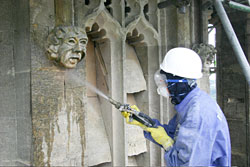 After recording the tower an assessment was undertaken and the decision
was made to employ the Jos/TORC abrasive pollutant removal system. This
was successful in that Damien, our operator, was able to remove pollutants
whilst leaving important colonies of lichens unharmed. We were then able
to do a stone-by-stone condition assessment and begin the process of conserving
the fabric.
After recording the tower an assessment was undertaken and the decision
was made to employ the Jos/TORC abrasive pollutant removal system. This
was successful in that Damien, our operator, was able to remove pollutants
whilst leaving important colonies of lichens unharmed. We were then able
to do a stone-by-stone condition assessment and begin the process of conserving
the fabric.
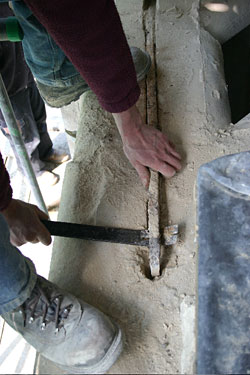 The other major decay factor was the presence of hundreds of
iron cramps in the ashlar face of the tower, the buttresses and pinnacles.
These cramps were corroding and the consequent pressure on the Bath stone
had been causing pieces of stone to pop off from a great height. Surprisingly
the cramps were generally less corroded on the exposed South West corner
and worse on the protected North; this may have been due to rapid wetting
and drying cycles preventing moisture from penetrating too deeply. The
cramps were removed and replaced with stainless steel versions. We discovered
that the tower octagon had been encircled with several layers of wrought
ironwork which had jacked up the top parapet section. These had to be tunnelled
out, surgically removed and also replaced with stainless steel.
The other major decay factor was the presence of hundreds of
iron cramps in the ashlar face of the tower, the buttresses and pinnacles.
These cramps were corroding and the consequent pressure on the Bath stone
had been causing pieces of stone to pop off from a great height. Surprisingly
the cramps were generally less corroded on the exposed South West corner
and worse on the protected North; this may have been due to rapid wetting
and drying cycles preventing moisture from penetrating too deeply. The
cramps were removed and replaced with stainless steel versions. We discovered
that the tower octagon had been encircled with several layers of wrought
ironwork which had jacked up the top parapet section. These had to be tunnelled
out, surgically removed and also replaced with stainless steel.
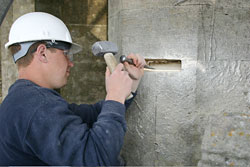
Whilst we were there a study was undertaken by Dr David Hill of Bristol
University of the lichen communities on the tower with the aim of recording
the lichen flora present, estimating its diversity and checking the health
of common species (that may be acting as environmental indicators) found
at all points up the tower. Lichens are the symbiotic relationship between
algae and fungi, and are a 'pioneer' species: the first colonizer of a
given environment. They are pH specific and easily affected by environmental
changes in acidity and alkalinity, 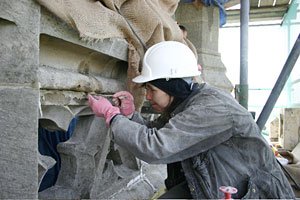 Since the reduction in atmospheric SO2
many acid-loving lichens are in decline, a decline exacerbated by new forms
of nitrogen based atmospheric pollutants.
Since the reduction in atmospheric SO2
many acid-loving lichens are in decline, a decline exacerbated by new forms
of nitrogen based atmospheric pollutants.
Church towers and church yards are of supreme importance for lichen conservation, particularly in areas where there are no natural outcrops of rock. Of the 1700 British species, over 300 have been found growing on churchyard stone in lowland England. Almost half the species are rare, having been noted in fewer than ten churchyards. Some seldom occur in any other habitat. In the not too distant past it was common to be asked in schedules of work to liberally apply biocide to carved elements and wrap with black plastic in order to destroy lichen.
In urban environments, lichens play an important part in contributing as primary producers to the ecological environment for the benefit of other wildlife. They also determine the appearance of old buildings, enhancing old stonework with their texture and mosaics of colour, and it is now thought they may actually protect some building materials from decay.
As a rule of thumb the older the church tower the richer is the lichen species diversity. I believe that Good lichen and building conservation practice go hand in hand, for example, as repointing in soft lime mortar respects both stone and nature, and lime sheltercoats lightly applied and thoroughly rubbed in will not affect resident populations. Thickly applied and inadequately rubbed lime sheltercoats leave walls looking denuded, bland and custardy. The conservation of lichens can thus assist as a guage to the sensitivity and quality of the conservation repairs being executed.
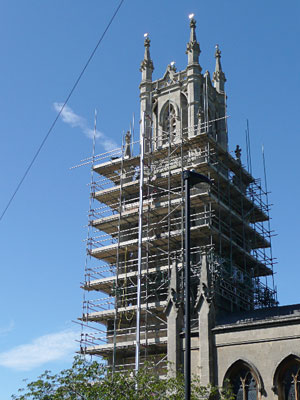 The scaffolding at St Stephen's had had been in place for a year before
work commenced. This ensured that the stonework repairs could be surveyed
accurately prior to the preparation of a schedule of works for the tender
process. One of the aims of the separate lichen survey was to determine
whether the shading of the scaffolding was having a detrimental effect
on the flora. This evidence had to be considered with any vertical differences
that could be caused by pollution or other environmental factors.
The scaffolding at St Stephen's had had been in place for a year before
work commenced. This ensured that the stonework repairs could be surveyed
accurately prior to the preparation of a schedule of works for the tender
process. One of the aims of the separate lichen survey was to determine
whether the shading of the scaffolding was having a detrimental effect
on the flora. This evidence had to be considered with any vertical differences
that could be caused by pollution or other environmental factors.
The main basis of this approach was that the emergent spires at the top of the tower were unaffected by the scaffolding. Therefore it was assumed that the flora on these spires could be compared with the rest of the tower. The scaffolding was found to have had little or no marked effect. In some respects lichens can be surprisingly resilient; in 2005 two species of lichen were sealed in a capsule and launched on a Russian Soyuz rocket, once in orbit the capsules were opened and the lichens were directly exposed to the vacuum of space with its widely fluctuating temperatures and cosmic radiation. After fifteen days the lichens were brought back to earth and were found to be unaffected by their trip.
Until recently, due to the historic overriding effects of SO2, little research work has been undertaken on the response of lichens to other forms of manufactured airborne pollutants. With clean air legislation and the demise of manufacturing industry it has been noticed that lichens are being affected by other nitrogen based pollution and are useful indicators of possible future declines of plant population within other ecological systems.
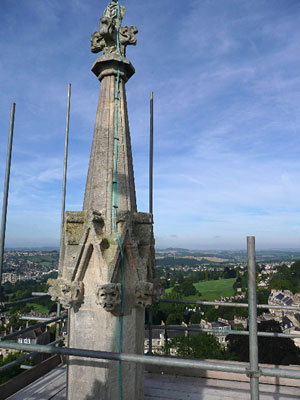 Nitrogen based emissions (caused by the increase in intensive agricultural
practices, and vehicular discharges), are rising and it is worrying that
this will encourage the dominance of nitrogen-tolerant lichen varieties
in urban areas. This pollution could well be depleting plantlife in other
delicate eco systems such as grasslands, wetlands and bogs. Recent estimates
by DEFRA s National Focal Centre for Critical Loads estimate that large
areas of ecosystems in the UK are at risk from eutrophication (excessive
environmental enrichment by nutrients such as nitrogen). There is now emerging
evidence for changes in the plant species across semi-natural areas of
the UK, and deposition of nitrogen oxides is likely to be part of the problem.
Nitrogen based emissions (caused by the increase in intensive agricultural
practices, and vehicular discharges), are rising and it is worrying that
this will encourage the dominance of nitrogen-tolerant lichen varieties
in urban areas. This pollution could well be depleting plantlife in other
delicate eco systems such as grasslands, wetlands and bogs. Recent estimates
by DEFRA s National Focal Centre for Critical Loads estimate that large
areas of ecosystems in the UK are at risk from eutrophication (excessive
environmental enrichment by nutrients such as nitrogen). There is now emerging
evidence for changes in the plant species across semi-natural areas of
the UK, and deposition of nitrogen oxides is likely to be part of the problem.
At St Stephen's church the species richness, health and cover of lichens was significantly less at the lower levels (below 15m), where air pollution is greater, than at the upper levels and the top above the scaffolding. Confirmation of these findings would only be possible by carrying out similar projects on other church towers; something that many Architects and Surveyors could help with.
